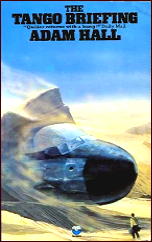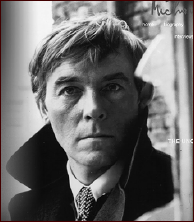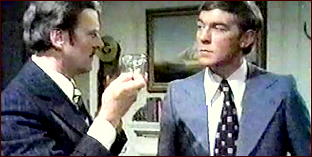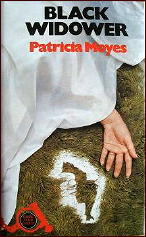Tue 4 Oct 2016
A Book! TV Show!! Review by Michael Shonk: ADAM HALL – Tango Briefing.
Posted by Steve under Reviews , TV Espionage & Spies[16] Comments
ADAM HALL (ELLESTON TREVOR) – The Tango Briefing. Doubleday, US, hardcover, 1973. Dell, paperback, 1974. First published in the UK by Collins, hardcover, 1973.

QUILLER. “Tango Briefing.” BBC One; September 5, 1975. Written by Adam Hall, based on characters he created. Cast: Michael Jayston as Quiller and Moray Watson as Angus Kinloch. Guest Cast: Nigel Stock as Loman, Prunella Gee as Diane, Reg Lye as Chirac and Paul Angelis as Vickers Designer: Peter Blacker. Produced by Peter Graham Scott. Directed by David Sullivan Proudfoot.
My experience with Quiller is limited. I began with the disappointing film QUILLER MEMORANDUM, then the good but nothing special book NINTH DIRECTIVE. Recently I read the book TANGO BRIEFING and watched a rare copy of the British TV episode based on the book.
Both versions of TANGO BRIEFING were written by Adam Hall (Elleston Trevor) and featured Quiller searching for a lost plane in the Sahara desert. A mission that had already cost lives.
I enjoyed the book, and even though it was fifth in the Quiller series it felt like an introduction story to the character. Narrated in first person by the character Quiller, and while he remained a self-effacing enigma, the book was filled with many details about his job and his life (which amounted to the same thing).

Actor Michael Jayston (TINKER TAILOR SOLDIER SPY, 1979) was well chosen for the role, better than the film’s version played by George Segal. Quiller has a lack of respect and trust for authority figures. Segal played it with more Connery-as-Bond-like humor, while Jayston had a meaner, rude touch.
The book TANGO BRIEFING was a well-written thriller full of tension and excitement. The TV episode was loyal to the book, but due to time and budget, made a few changes, changes that stripped the story of much of its suspense and drama.
Few have ever seen the QUILLER TV series. Even in the collectors market the series is difficult to find. Apparently only three episodes of the series thirteen survive. Luckily TANGO BRIEFING was one of them. The short-lived series aired only once on the BBC and was never shown again. Its episodes met the same fate of many BBC genre series of that era such as DOCTOR WHO, and ADAM ADMANT LIVES (reviewed here ) when the stuffy old men at BBC in a fit of snobbery purged its entertaining non-socially conscious series from its warehouse.
Anyone aware of the TV series probably best remembers it for its popular theme song written by Richard Denton and Martin Cook (HONG KONG BEAT, THE GREAT EGG RACE).
The song was released on a 45 record with “General Direction†from QUILLER soundtrack on the B-side.
The mission in TANGO BRIEFING was to recover the cargo of a downed plane in the Sahara desert. The mission had gone bad and The Bureau sends Quiller in to complete the job. He was not told why the plane’s cargo was so important or what it was, but he realized it was vital to the British government that he reach the plane before the local Algerian government or anyone else who might be looking for it.
His “director†on the mission was Loman. Loman would make the plans and handle all the details while “the executive†or “ferret†Quiller was out in the field. The two had worked together before and neither liked the other or approved of the other’s methods.
After Quiller met with Loman there is an attempt on his life. In the book Quiller barely escaped alive and was physically weakened for the rest of the adventure, while in the TV episode he escapes with no injuries as a young native sets off the trap. I am not sure why writer Hall made the change but it was an important one.

The book Quiller is a superspy, a man able to do what few men can. Forced to overcome his injuries, Quiller goes beyond the average spy. From watching the three available episodes, the TV series producers seemed to want to make Quiller a more fallible realistic human but keeping Quiller’s arrogance and attitude. Unlike the book Quiller the TV Quiller was an unlikable one-dimensional character.
Every scene in the book added to the risks for Quiller, with time running out and others getting closer. TANGO BRIEFING the book makes powerful use of time and its passing. But the TV episode limited by its hour length could not fit it all in and what was used often felt contrived.
Four of the book’s characters made it from book to TV episode. Besides Loman, the other member of Quiller’s support team was inexperienced radio operator Diane. The character served a better purpose in the book with Quiller’s disapproval of her inexperience and concern for her youth adding tension and jeopardy to the story. The character of Diane was badly misused in the TV episode. TV Quiller was fast to forgive her inexperience and shook her hand accepting her to the team, there were G-rated hints of possible romance, and a scene was clumsily dropped in where she beat up a bad guy who attacked her in the radio room.
Two local characters, Chirac, the man who flies Quiller to the desert, and Vickers, the freelance oil driller, make it to the TV episode. Chirac goes from the book’s lovable old ex-war hero to the TV episode’s weak link. Vickers was a minor character in the book. His appearances in the TV episode were obviously forced by the need to foreshadow the TV’s version different ending.
Then there is the desert search for the plane that takes up much of the book and the TV episode. The TV version greatest mistake was to abandon the book’s first person narration. The scenes in the desert are among the highlights of the book. Quiller’s narration allows us inside the character, fleshing him out. We may not learn his real name or details of his past but we do learn how he thinks and feels. This is where Quiller becomes someone we care about.
In the TV episode, plot information and characterization was limited to the radio conversations between Quiller and Diane and Loman at the radio base in Kaifra. Without Quiller’s explaining his thoughts and exploring the details of his situation, we never feel his fear and stress as we do reading the book. This left the story in the TV version underdeveloped and less powerfully dramatic.
While the QUILLER theme song is great, the episode soundtrack was awful and let down the episode. The desert scenes could have worked better if the soundtrack had supplied the emotions of the scenes that the narration gave readers in the book.
Director David Sullivan Proudfoot (WARSHIP) did his best. His highlight was a shot of the shadow against a desert dune of a vulture circling over an unconscious Quiller.
The two versions differed in endings. The book’s final scenes would have made an exciting end for a theatrical film. The TV ending was weak, contrived and obvious.
The book is well worth reading. It is hard to believe the same man who wrote the book wrote the TV version. I suspect Hall’s final draft was not the final shooting script.
SOURCES:
Action TV: http://www.startrader.co.uk/Action%20TV/guide70s/quiller.htm
The Unofficial QUILLER website http://www.quiller.net
The Encyclopedia of TV Spies by Wesley Britton (BearManor Media, 2009)
